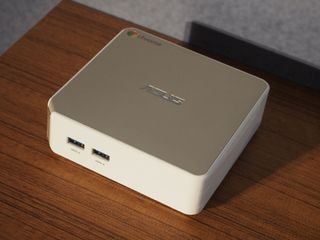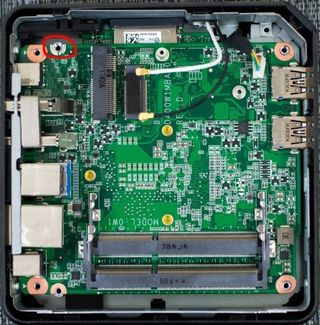How to install LibreElec [OS for Kodi] on Chromebox

A Chromebox is a pretty cool and inexpensive way to get yourself (or your kids!) online with Chrome OS. They're easy to use and keep you safer than most computers while you work or play around. But they're also just a regular compact-form PC when it comes to the hardware.
That means it's easy to slap another operating system on one if you take a little time to find the right directions. That's what we're going to talk about right here and get you started with installing LibreElec on your Chromebox.
What is LibreElec?

According to the official site, LibreELEC is "Just enough OS" for Kodi; it's a Linux distribution built to run Kodi on current and popular media center hardware — like a Chromebox.
It's a very slim Linux OS that's built for running Kodi without any extra overhead so everything runs as well as possible on low-powered hardware. That means you can use less hardware to do everything or you can get better performance out of the type of hardware that's inside a Chromebox.
In other words, everything will be really fast when you're moving through the menus and looking for something to listen to or watch.
Setting up the hardware
There is a LibreElec installation file for every Chromebox that's been made so far. Since we can't cover them all, we're going to focus on the ASUS Chromebox M004U. It's probably the most popular Chromebox and one of the cheapest. If you are using a different Chromebox, the instructions are very similar but not exactly that same. Don't use these directions on anything besides an ASUS Chromebox M004U (either the 2GB or 4GB version)!
Be an expert in 5 minutes
Get the latest news from Android Central, your trusted companion in the world of Android
See the Chromebox M004U on Amazon
You'll need to prepare your Chromebox and get it into developer mode and (optionally) disable the write-correct on the hardware to swap out the OS. It's not difficult but usually involves opening the case. To get into developer mode (this erases all the existing data!):
- Insert a paperclip into the small home icon next to the SD card slot to press the recovery button.
- Turn on the Chromebox and then remove the paperclip.
- At the recovery screen press Ctrl + D to enter Developer Mode.
- Press the recovery button again to confirm.
Give it a few minutes and you'll see the developer mode boot screen. When everything is finished booting, shut it all off.

Disabling the firmware write-protect involves opening the case and removing a screw on the mainboard. We're going to replace Chrome with LibreElec so this is a necessary step. Don't worry! It's not hard and the official Kodi Wiki has complete instructions for every Chromebox along with photos. Take a minute to gather up a screwdriver and have a look.
Installing the software
You'll need two USB thumb drives to backup Chrome OS and get your installation media during this step. Any thumb drive that's 8GB or larger will work here, and you need to know that you will lose any data on it once we get started. We're using the Chromebox EZ-Script to do this the easy way.
- Make sure you are connected to the internet and boot to Chrome OS, but don't log in.
- Press Ctrl + Alt + F2 to open a command line.
- Log in as chronos with no password.
- Download the Chromebox EZ-Script using this command:
curl -L -O http://mrchromebox.tech/setup-kodi.sh- Run the script with this command:
sudo bash setup-kodi.shThe installer

- Press 5 to start a Standalone Setup. This updates and overwrites the coreboot firmware so we can replace Chrome. Don't use this file if you do not have an ASUS Chromebox M004U!
- Insert one of your thumb drives when prompted to back up the factory software.
- When prompted again, remove that thumb drive. Label it Chrome OS and store it somewhere. Then insert the second thumb drive to build the LibreElec installer.
- Reboot with the thumb drive inserted.
When you get to the boot menu, press the Escape key and choose the thumb drive as the boot device. Pressing Escape a second time will skip the boot menu and force your Chromebox to try and boot from the hard drive.
- Select Run Installer.
- Choose Quick Install.
Follow the easy wizard to install LibreElec to the Chromebox storage. Here are the recommended settings for the ASUS M004U using the default skin (called Confluence):
- System > OpenELEC > System: Automatic Updates: Auto
- System > OpenELEC > Services: Enable Bluetooth: Selected if you're using Bluetooth. Unselected if not.
- System > Settings > System: Settings Level: Expert (Don't worry, expert in this case only means you can see all the settings)
- System > Settings > System > Video Output: Vertical blank sync: Enabled during video playback
- System > Settings > System > Power Saving: Shutdown function: Suspend (This sets IR "switch" to suspend/resume instead of on/off)
- System > Settings > Videos > Acceleration: Use VC-1 VAAPI: Selected
- System > Settings > Videos > Acceleration: Use SW Filter for VAAPI: Selected
When you're done, reboot one last time. You'll start up running LibreElec and Kodi will be front and center, waiting for you to grab some add-ons and fine tune your new media center!

Jerry is an amateur woodworker and struggling shade tree mechanic. There's nothing he can't take apart, but many things he can't reassemble. You'll find him writing and speaking his loud opinion on Android Central and occasionally on Twitter.
